تاریخ جهان از ماموت تا فیسبوک20
سِلتها (کِلتها) The Celts
در قسمتِ پیش از همو نالدی[۱] (انسانِ نالدی)؛ تبار زوال یافته انسان مُدرن یا بهتر بگویم نزدیکترین خویشاوند به انسان مدرن که به تازگی کشف آن اعلام شده، صحبت کردم. هومو نالِدی بهنوعی به بحث تاریخ جهان از ماموت تا فیسبوک مربوط میشد بویژه که در آغاز این بحث به تکامل انسان و «هوموساپینس»ها[۲] یعنی انسان اجتماعی و هوشمند امروزی اشاره شده بود.
اسم «نالدی» برگرفته از محل کشف آن - غاری به نام «ستاره در حال طلوع»[۳] در آفریقای جنوبی است که بزرگ ترین یافته فسیلی به هم پیوسته از بقایای انسانی در آن بهدست آمدهاست. نالدی در زبان تسوانا[۴]، که یکی از زبانهای محلی آفریقای جنوبی است، به معنی «ستاره» است.
...
در ادامه مباحث تاریخ حهان از ماموت تا فیسبوک به سِلتها میپردازم.
ـــــــــــــــــــــــــــــــــــــــــ
سِلتها از ایتالیا و اسپانیا هم سر درآوردند
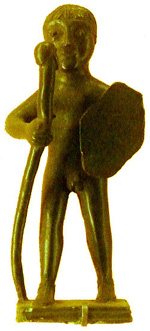 سِلتها[۵] یا کِلتها گروهی از قبایل بودند که لهجه هند و اروپایی داشتند و نخستین بار در هزاره دوم قبل از میلاد در جنوب غربی آلمان و شمال فرانسه پاگرفتند. آنان که به اسب و سلاح آهنی مجهز بودند بسرعت در سراسر اروپا پخش و پلا شده، به جزایر بریتانیا هم رسیدند و بعداً از ایتالیا و اسپانیا سر درآوردند. سِلتها با مقدونیه جنگیدند و وارد آسیای صغیر شدند و مراکز هلنیسم (ﻣﻨﺎﻃﻖ ﺍﻣﭙﺮﺍﺗﻮﺭﯼ ﯾﻮﻧﺎﻥ ﭘﺲ ﺍﺯ ﻣﺮﮒ ﺍﺳﮑﻨﺪﺭ) را غارت نمودند و با ثروتی که از تجارت و تاخت و تاز بدست آوردند استیلای خود را بر اروپای مرکزی حفظ کردند.
سِلتها[۵] یا کِلتها گروهی از قبایل بودند که لهجه هند و اروپایی داشتند و نخستین بار در هزاره دوم قبل از میلاد در جنوب غربی آلمان و شمال فرانسه پاگرفتند. آنان که به اسب و سلاح آهنی مجهز بودند بسرعت در سراسر اروپا پخش و پلا شده، به جزایر بریتانیا هم رسیدند و بعداً از ایتالیا و اسپانیا سر درآوردند. سِلتها با مقدونیه جنگیدند و وارد آسیای صغیر شدند و مراکز هلنیسم (ﻣﻨﺎﻃﻖ ﺍﻣﭙﺮﺍﺗﻮﺭﯼ ﯾﻮﻧﺎﻥ ﭘﺲ ﺍﺯ ﻣﺮﮒ ﺍﺳﮑﻨﺪﺭ) را غارت نمودند و با ثروتی که از تجارت و تاخت و تاز بدست آوردند استیلای خود را بر اروپای مرکزی حفظ کردند....
اصطلاح سِلتی اشاره به کسانی است که بزبان سِلتی صحبت میکنند یا اجداد خود را از مناطقی که زبانهای سِلتی در آنجا رایج بوده میدانند. مثل ایرلندیها، بخشی از اسکاتلندیها، جزیره مَن[۶]، واقع در دریای ایرلند که بین بریتانیا و ایرلند واقع شده، همچنین اهالی ویلز و کورنوال[۷] در ناحیه جنوب غربی انگلستان، و...
ـــــــــــــــــــــــــــــــــــــــــ
سِلتها زبان نوشتاری نداشتند
سِلتها آهنگران ماهری بودند و ابزار آهنی، سلاح آهنی و جواهرات ظریف میساختند. آنها جنگجویانی خشن اما بی نظم بودند برای همین رومیها به آسانی شکست شان دادند.
سِلتها زبان نوشتاری نداشتند و قوانین، تشریفات مذهبی و داستانهای خود را به طور شفاهی به دیگران منتقل میکردند. اهل جشن و تفریح هم بودند. به برگزاری چشنها اهمیت میدادند.
...
سِلتها شهری نداشتند و موجودیتی شبانی را، در قالب زندگی سادهٔ کشت و زرع و روستایی، ترجیح میدادند. از همین رو؛ دنیای یونانی-رومی، سِلتیها را بَربَر و وحشی معرفی میکند. آنان اگر چه در زمینه کاربرد زبان و اصول نسبت به رومیان و یونانیان عقبتر بودند، اما، فاقد تمدن نبوده و قوانینی داشتهاند؛ با طبقهبندیهای اجتماعی و نیز سنتها و رسوم مذهبی.
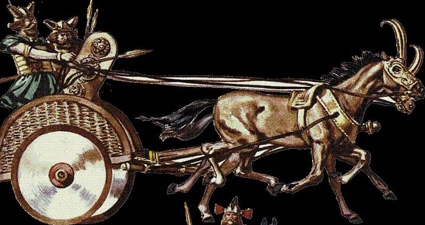
جنگجویان سِلت ظاهر و صدای ترسناکی داشتند و شلوارهای زبر و خشن میپوشیدند. اما گاه به هنگام جنگ به صورت برهنه و با یک طوق (گردنبند)، به میدان رفته، سپرهایی از جنس برنز با چوب در دست میگرفتند و با شمشیر، نیزه و قلاب سنگ میجنگیدند.
ـــــــــــــــــــــــــــــــــــــــــ
نه هرکه دارد شمشیر حرب باید کرد
بین سِلتیها؛ قهرمانان جنگی از موقعیت بالایی برخوردار بودند. آنان سوار بر ارابه چوبی که بهوسیله اسبهای تنومند کشیده میشد، وارد میدان جنگ میشدند، یک ارابهران اسبها را در میدان جنگ هدایت کرده و همزمان جنگجو، نیزه خود را به طرف دشمن پرتاب میکرد. وقتی شرایط جنگ مشکل میشد، جنگجویان از روی ارابهها به پایین میپریدند و شمشیر بدست میگرفتند. در صورتی که یک فرمانده نظامی در خطر قرار میگرفت، ارابهران او آماده بود تا او را سوار کرده و به محل امنی انتقال دهد.
...
 سِلتها بعد از هر پیروزی جشنهای بزرگی برگزار میکردند. این ضیافت چندین روز طول میکشید. شعرا و نوازندگان با داستان پیروزیها و شجاعتهای قهرمانان قبیله، مردم در حال تفریح را سرگرم میکردند.
سِلتها بعد از هر پیروزی جشنهای بزرگی برگزار میکردند. این ضیافت چندین روز طول میکشید. شعرا و نوازندگان با داستان پیروزیها و شجاعتهای قهرمانان قبیله، مردم در حال تفریح را سرگرم میکردند.معابد محلی سِلتیها کوچک بود اما معابد جامعتر، تحت تأثیر تمدن یونان و روم تزیین میشدند. برای سِلتیها تپهها و آبها مقدس و حیوانات، نمادی از قدرت خداوندی محسوب میشد.
برخلاف رومیان و یونانیان، سلتیها به نگارش و ادبیات توجه چندانی نداشتند و از همین رو نتوانستند، سنتها، اسطورهها، قوانین و دیگر عقاید و باورهایشان را ثبت و نگهداری کنند، بهمین دلیل اسطورههای اصلی سلتی، به وسیله گفتهها و نقلهای کلامی از نسلی به نسل دیگر منتقل شدهاست.
البته اسطورههای سِلتی در ادبیات اولیه ولزی و ایرلندی تا حدودی حفظ شدهاند و پوسیدونیوس[۸](از فیلسوفان مشهور یونان) و دیگر نویسندگان کلاسیک به وصف اعمال دینی آنها پرداختهاند. گفته میشود فولکلور اروپای غربی غالباً از سِلتها سرچشمه گرفتهاست.
...
سلتها که به شمشیرهای خود خیلی غره بودند؛ وقت و بیوقت آتش جنگ برمیافروختند. غافل از اینکه «نه هرکه دارد شمشیر حرب باید کرد»
سِلتها سرهای بریده دشمنان شکست خورده را به عنوان یادگارهای مقدس، نزد خود نگه میداشتند و فخر میفروختند.
اما دوران غرّگی و نازیدن به شمشیر بسر آمد. از قرن ۴ میلادی بهبعد کم کم قدرت خود را از دست دادند و با تاخت و تاز ژرمنها بسیاری از متصرفاتشان بویژه در آلمان از دست رفت و در نهایت با فتح «گل»[۸] به دست قیصر (ژولیوس سزار رهبر سیاسی و نظامی جمهوری روم)، استقلال سلتیها در قاره اروپا به پایان رسید.
(گُل منطقهای در غرب اروپا است که امروزه فرانسه، بلژیک، غرب سوییس و بخشهایی از هلند و آلمان - بخش غربی رود راین - در آن قرار دارند.)
پانویس
- Homo naledi
- Homo sapiens
- Rising star Cave
- Sesotho
- The Celts
- Ellan vannin or mannin
- Cornwall
- Posidonius
- Gaul گُل منطقهای در غرب اروپا است که امروزه فرانسه، بلژیک، غرب سوییس و بخشهایی از هلند و آلمان - بخش غربی رود راین - در آن قرار دارند.
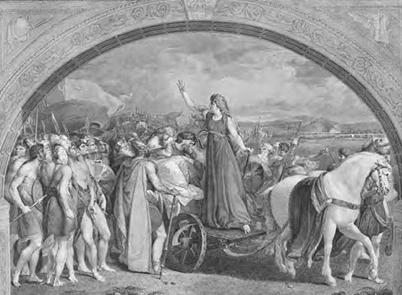
Celtic warriors
The celts (called "Gauls" by the Romans) were not a single people but consisted of scattered tribes ruled chiefs. Originally from an area north of the Alps, some tribes migrated south a 400 BCE, clashing with the Greeks and Romans. Archaeologists call critic culture of this period La Tene, after a Swiss site. By 100 BCE the La Tene culture had spread throughout Europe.
Celtic gods
Celtic religion was tied in with the farming year and nature. Hundreds of gods worshipped under different names throughout the Celtic world. Here are four
Belenus
The god of Sun and fire, Belenus was associated with the Beltane festival on 1 May, when fires were lit to purify cattle.
Brigit
Also known as Brigantia, Brigit was goddess of healing, poetry, and fertility. In Ireland she was later adopted as a Christian saint.
Celtic gods
Celtic religion was tied in with the farming year and nature. Hundreds of gods worshipped under different names throughout the Celtic world. Here are four
Belenus
The god of Sun and fire, Belenus was associated with the Beltane festival on 1 May, when fires were lit to purify cattle.
Brigit
Also known as Brigantia, Brigit was goddess of healing, poetry, and fertility. In Ireland she was later adopted as a Christian saint.
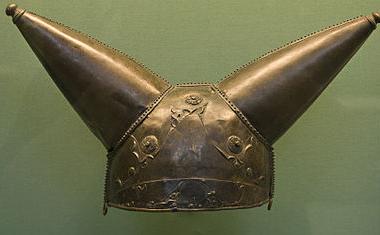
Cernunnos
This horned god was associated with fertility, nature, harvest, and the underworld.
Epona
The goddess Epona was the protector of horses, Roman soldiers adopted her, and built her a temple in Rome.
The world of the druids
Celtic priests were called druids. The druids carried out many rituals and may have offered up human sacrifices to the gods. This picture shows a druid using a golden sickle to cut mistletoe in a grove of oak trees. Mistletoe was a sacred plant to the Celts.
Celtic hero
This Celtic head, found at a site near Prague, in the Czech Republic, has staring eyes and a swept-back moustache. Around its neck is a torc the metal neck ring worn by Celtic warriors. The Romans admired the courage of the Celts, but thought they were boastful and drank too heavily.
This horned god was associated with fertility, nature, harvest, and the underworld.
Epona
The goddess Epona was the protector of horses, Roman soldiers adopted her, and built her a temple in Rome.
The world of the druids
Celtic priests were called druids. The druids carried out many rituals and may have offered up human sacrifices to the gods. This picture shows a druid using a golden sickle to cut mistletoe in a grove of oak trees. Mistletoe was a sacred plant to the Celts.
Celtic hero
This Celtic head, found at a site near Prague, in the Czech Republic, has staring eyes and a swept-back moustache. Around its neck is a torc the metal neck ring worn by Celtic warriors. The Romans admired the courage of the Celts, but thought they were boastful and drank too heavily.
Wild warriors
Brennus
This chieftain led an army of Gauls to attack Rome in 390 BCE. Guard geese sounded the alarm, but the Romans had to give Brennus gold to make him leave.
Caractacus
From his Welsh hideout, Caractacus resisted the Roman invasion of Britain for six years, but eventually he was captured and taken to Rome.
Boudicca
Queen of the Iceni, a tribe in eastern England, Boudicca led a rebellion against the Romans in 61 CE.
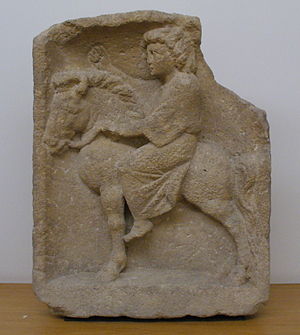 After the Romans
After the Romans
In Gaul and Britain, Celtic culture merged with that of the occupying Romans. After the Romans left, Germanic invaders pushed the surviving Celts back into Brittany in France, and into Wales, and southwest Cornwa Scotland in Britain.
Working in metal
The Celts were skilled craftspeople, working in gold, bronze, and iron. They loved to decorate their metalwork with intricate patterns of circles curves, whorls, and spirals, and with animal and plant motifs.
400 BCE
Groups of Celts invaded the Po Valley in northern Italy and settled there.
390 BCE
The warrior leader Brennus led an army of Gauls to attack and capture the city of Rome.
279 BCE
An army of Celts invaded Greece and sacked the sacred shrine of Delphi.
Sacred mistletoe
225 BCE
The Romans defeated the Gauls of northern Italy at the Battle of Telamon.
101 BCE
The Roman general Marius defeated the invading Cimbri at the Battle of Vercellae.
58-51 BCE
Julius Caesar fought a series of campaigns to conquer Gaul (France and Belgium).
43 CE
Emperor Claudius sent an army to begin the Roman conquest of Britain.
61 CE
Boudicca led a revolt of the Celtic tribes of Britain against the invading Romans.
This chieftain led an army of Gauls to attack Rome in 390 BCE. Guard geese sounded the alarm, but the Romans had to give Brennus gold to make him leave.
Caractacus
From his Welsh hideout, Caractacus resisted the Roman invasion of Britain for six years, but eventually he was captured and taken to Rome.
Boudicca
Queen of the Iceni, a tribe in eastern England, Boudicca led a rebellion against the Romans in 61 CE.
 After the Romans
After the Romans In Gaul and Britain, Celtic culture merged with that of the occupying Romans. After the Romans left, Germanic invaders pushed the surviving Celts back into Brittany in France, and into Wales, and southwest Cornwa Scotland in Britain.
Working in metal
The Celts were skilled craftspeople, working in gold, bronze, and iron. They loved to decorate their metalwork with intricate patterns of circles curves, whorls, and spirals, and with animal and plant motifs.
400 BCE
Groups of Celts invaded the Po Valley in northern Italy and settled there.
390 BCE
The warrior leader Brennus led an army of Gauls to attack and capture the city of Rome.
279 BCE
An army of Celts invaded Greece and sacked the sacred shrine of Delphi.
Sacred mistletoe
225 BCE
The Romans defeated the Gauls of northern Italy at the Battle of Telamon.
101 BCE
The Roman general Marius defeated the invading Cimbri at the Battle of Vercellae.
58-51 BCE
Julius Caesar fought a series of campaigns to conquer Gaul (France and Belgium).
43 CE
Emperor Claudius sent an army to begin the Roman conquest of Britain.
61 CE
Boudicca led a revolt of the Celtic tribes of Britain against the invading Romans.
History Year by Year/Peter Chrisp, Joe Fullman, Susan Kennedy

در همین زمینه
...
...
hamneshine_bahar@yahoo.com
برای ارسال این مطلب به فیسبوک، آیکون زیر را کلیک کنید:![]() facebook
facebook